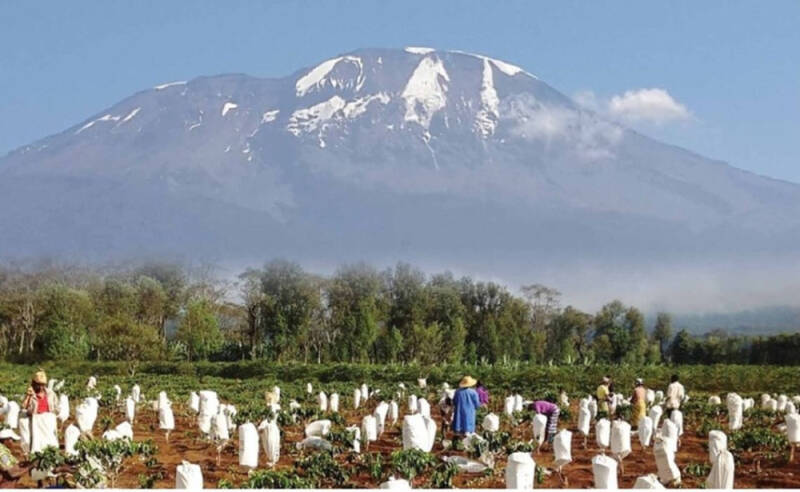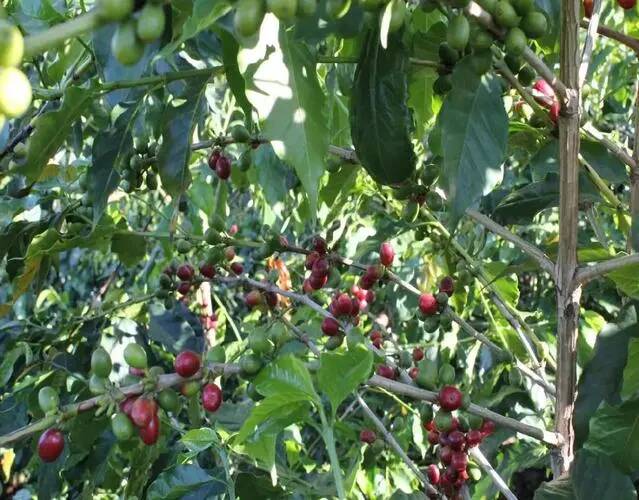Coffee cultivation in Tanzania, introduction to Mount Kilimanjaro Iron pickup Coffee
In Africa, there are many famous coffee producing countries, such as Ethiopia, Kenya and Rwanda, but there are also some countries that should not be underestimated. For example, coffee in Tanzania, which belongs to one of the three coffee giants in Africa, has been nicknamed "coffee gentleman" by Europeans.
Tanzania
Located in eastern Africa, south of the equator, Tanzania is a land and sea country. The east is bordered by the Indian Ocean and bordered by Kenya, Uganda and other eight countries. The whole terrain of Tanzania is high in the northwest and low in the southeast, showing a ladder shape as a whole. The East African Rift Valley runs north and south from the east and west of Lake Malawi, and the Kibo peak of Kilimanjaro in the northeast of the country, which is 5895 meters above sea level, is the highest peak in Africa.

The eastern coastal areas and inland lowlands of the country have a savanna climate, while the western inland plateau has a tropical mountain climate. The annual average temperature is between 21 ℃ and 26 ℃. Coffee beans are mainly grown in Mount Kilimanjaro and the southern region. Mount Kilimanjaro is an extinct volcano and high above sea level, which makes Tanzanian coffee with mellow texture, suitable acidity and strong aroma, compared with neighboring Kenya. Although a little less bright acidity, softer acidity, but will be a little more sweet, red wine flavor.
Coffee development
In some coffee history, coffee was introduced into Tanzania from Ethiopia in the 16th century, and later became a cash crop in Tanzania during the German colonial period. At present, the country is growing iron pickup, bourbon, Kent and self-developed disease-resistant and disaster-resistant varieties.

The first co-operative (KNRA) was established in 1925, and its producers had more freedom to sell directly to London. The Tanzanian Coffee Institute Tanzanian Coffee Research Institute (TaCRI) was established and operated in 2001 as a non-profit organization with the goal of revitalizing the coffee industry in Tanzania and raising the international profile of Tanzanian coffee.
Kilimanjaro, Mt.
In Tanzania, coffee is grown mainly on Kilimanjaro and in the south, 85% of which is grown on small farms. Mount Kilimanjaro is the highest mountain on the African continent with perennial snow, and coffee is grown in an area of 1050-2500 meters. High enough altitude, volcanic soil, and pure snow-melting water are the most suitable areas for growing coffee. The harvest time of coffee in Kilimanjaro is from July to December every year, and the main varieties are bourbon, iron pickup and Kent.
Iron pickup
The variety of iron pickup is less than one of the most important Arabica varieties of coffee in the world. This variety of plant is relatively tall, its yield is relatively low, easy to suffer from major diseases, but good quality, suitable for planting in high altitude areas, the higher the altitude, the better the quality. Because of its low production and high susceptibility to coffee's major diseases, it has been gradually replaced in most of the Americas, but it is still grown in Peru, the Dominican Republic and Jamaica, where it also made the present-day Jamaican Blue Mountains.
Washing treatment
Since most of them are grown on small farms, farmers send the harvested coffee berries to nearby processing. Curry farmers first pour the picked coffee berries into a large tank for flotation, and then use a pulp sieving machine to remove the outer skin and pulp of the coffee fruit, when the coffee beans are still attached to a slippery layer of pectin. Put the coffee beans with pectin in the fermentation tank for 16 hours and 36 hours, during which the microbes will decompose the pectin. After the fermentation is completed, a large amount of water is used to remove the pectin residue from the coffee beans. Finally, the washed coffee beans are dried in the sun. The water washing method has both soft and strong acidity, suitable mellow, sweet and spicy.
Qianjie Coffee Tanzania Kilimanjaro Coffee Bean production area: Kilimanjaro production area altitude: 1300-2000 m Variety: iron truck treatment: washing flavor: citrus honey berry nut tea feeling
Of course, Qianjie Coffee will buy coffee beans from Tanzania. This coffee bean from Kilimanjaro is washed. Qianjie will use the proportion of V60 Jade 15, 92 ℃ water temperature for cooking, the entrance will have a soft acidity, with citrus, berry, honey and nut flavor, soft tea taste, overall balance.
Important Notice :
前街咖啡 FrontStreet Coffee has moved to new addredd:
FrontStreet Coffee Address: 315,Donghua East Road,GuangZhou
Tel:020 38364473
- Prev

Can I make 30 grams of coffee at once? How much is the right amount of hand coffee powder to extract at one time?
Mom and Dad: "Don't you know how to make coffee? go and make everyone a cup." I:... I wonder if the coffee people at home during the Spring Festival are also staging this situational dialogue: under the eyes of a group of relatives and friends, they want everyone to have a few sips of coffee, grind dozens of grams of beans in one breath, and make more than a pot of beans.
- Next

Teach you to make 6 different kinds of coffee with sweet-scented osmanthus! The course of making Dirty Coffee with Osmanthus Latte
Qianjie opened the city for the third day, during which colleagues took out their own home specialties to share with each other, and there was even a box of sweet-scented osmanthus cakes in the snack pile, which reminded Qianjie of the sweet-scented osmanthus coffee. Don't say much, start making a cup and have an aftertaste right away! Why sweet-scented osmanthus? Sweet-scented osmanthus is a flower full of fragrance.
Related
- Why does hot American coffee taste bitter? Difference in proportional concentration between hot American and ice American
- Is espresso stored overnight in the refrigerator harmful to your body? Is frozen coffee better than freshly ground coffee?
- What parameters and proportions of water temperature should be used to grind and brew fresh coffee beans? Why can't I drink freshly roasted coffee right away?
- Customers have "changed" Manner's new products! Shop assistant: Please don't mess around!
- Remove sockets in customer areas at Starbucks stores?! Netizen: I won't go if I really tear it down
- What is the difference between the taste steps of sun-dried coffee and washed coffee? Why is sun-cured coffee sweeter and washed coffee sour?
- The recipe for salty grapefruit dirty is revealed! Coffee Festival salty grapefruit dirty coffee making materials parameters ratio milk share!
- How about the flavor of Sunlight 74158 at Sidamo Banshaha Mathieu Processing Factory in Ethiopia? 74158 Share the proportion of coffee brewing parameters!
- What effect does Italian American coffee with filter paper have? Will coffee taste better if it is put on filter paper at the bottom of the powder bowl?
- What is the color difference in coffee beans? What are the characteristics of honey processed coffee beans? Why are the anaerobically treated coffee beans uneven in color?

